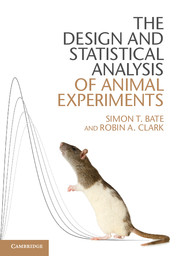4 - Randomisation
Published online by Cambridge University Press: 05 March 2014
Summary
In the previous chapter we gave recommendations regarding the randomisation procedures that should be performed when employing factorial, block and crossover designs. We also considered randomisation when differentiating between the various ways that an animal can be measured repeatedly. In this chapter we shall discuss some of the more general issues associated with randomisation and highlight how randomisation can influence the statistical analysis.
As a general rule it should be remembered that:
Where possible, the levels of each factor should be randomly assigned to the labels of the experimental design. So, for example, if a design is constructed (or obtained from a textbook) and the labels within the design are given as ‘1’, ‘2’ and ‘3’, then the actual treatments in the experiment (say drug X, drug Y and the control) should be randomly assigned to the labels ‘1’, ‘2’ and ‘3’.
Randomisation should ensure that each animal has an equal chance of being allocated to any of the experimental groups.
If a random factor is included in the statistical analysis, then we should always try to select the levels of the random factor randomly from a wider population of levels. For example, the study animals should be randomly selected from a larger population of animals. These study animals are then randomly assigned to the treatment groups. As we shall see, when we draw conclusions from the statistical analysis of an animal experiment, these conclusions can only be generalised to the wider population from which the animals were randomly taken. So, for example, the conclusions of an animal experiment conducted using males will not necessarily generalise to females.
Design first and randomise second. Leaving to chance the exact relationship between the factors in the design may be the easier option, especially if there are many effects that could influence the experimental results. However, we believe it is best to take into account as many effects as possible, by including corresponding factors in the experimental design, as this usually leads to a simpler analysis, more reliable results and more informed decisions.
This chapter, devoted to randomisation, is purposefully placed between the experimental design and statistical analysis sections of the book. This is to emphasise that randomisation provides a justification (it should be stressed not the only justification) for the statistical analysis. Randomisation can be seen as a link between the experimental design and the statistical analysis.
- Type
- Chapter
- Information
- The Design and Statistical Analysis of Animal Experiments , pp. 122 - 131Publisher: Cambridge University PressPrint publication year: 2014

